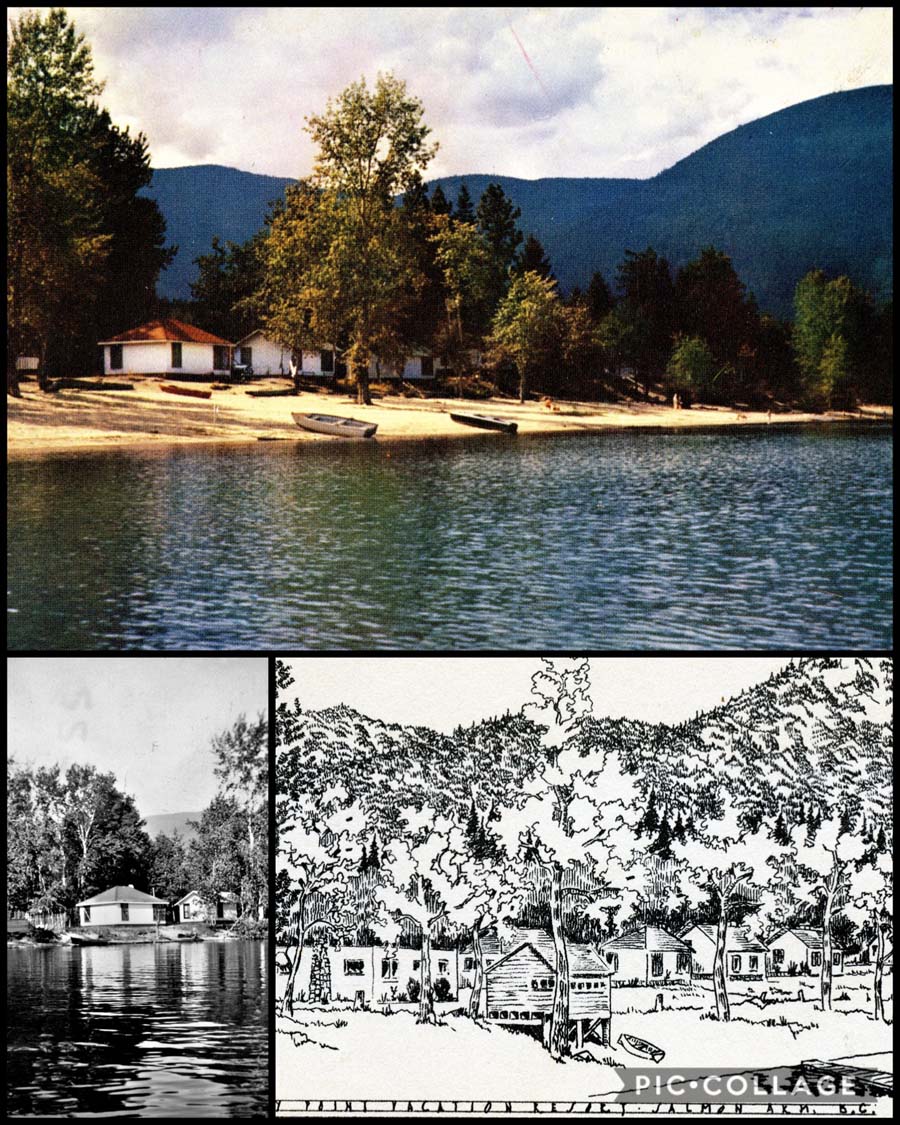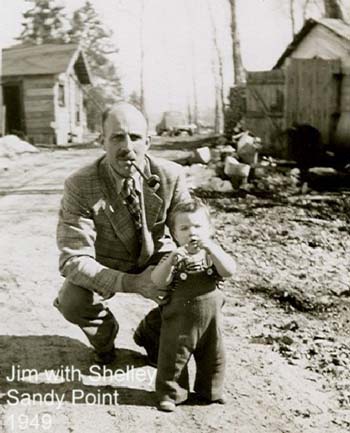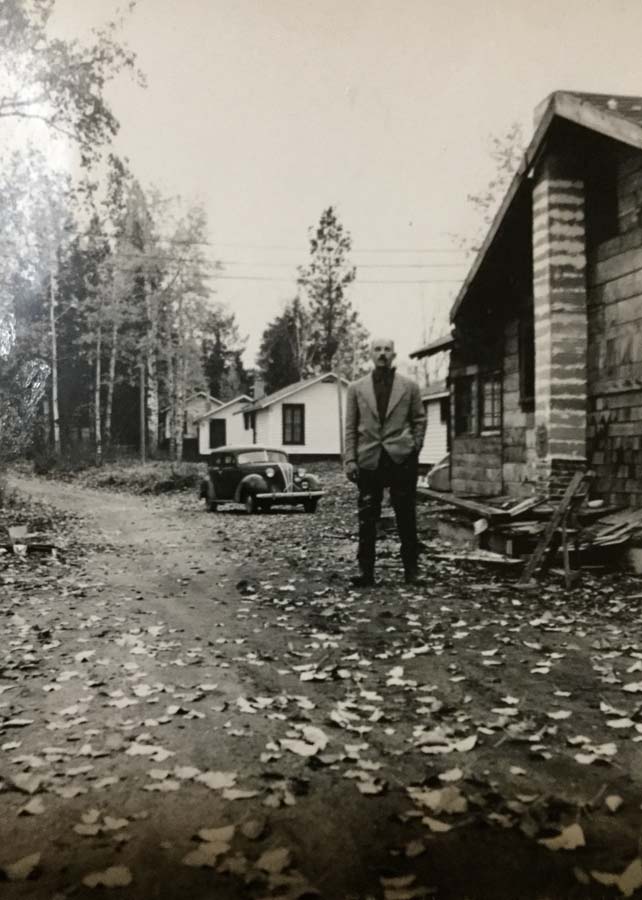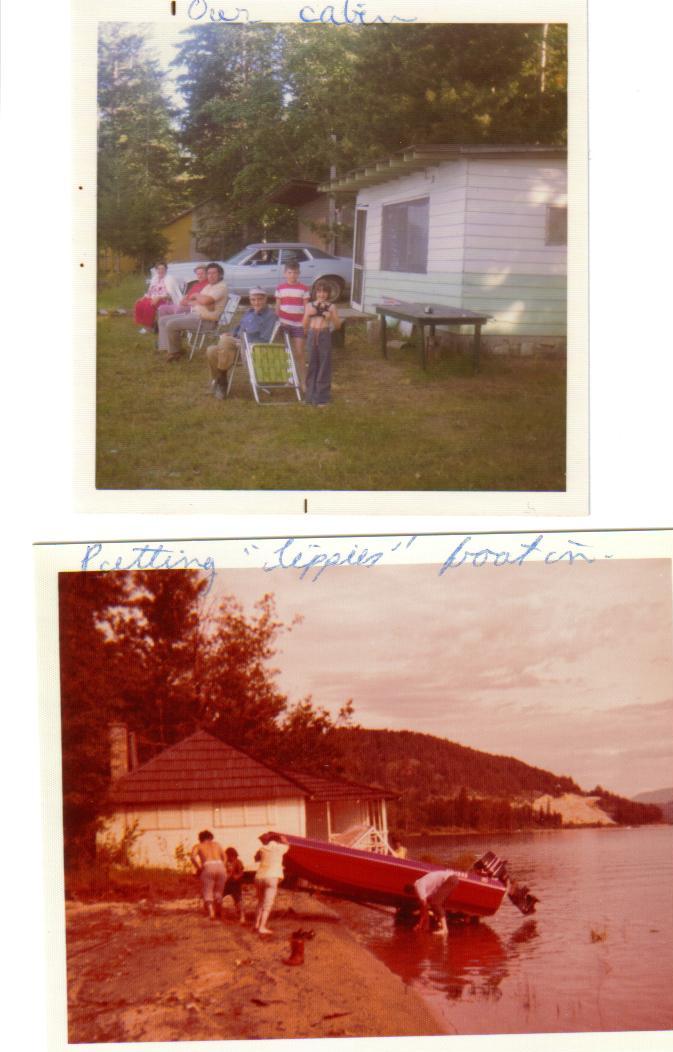Return to main Vanishing B.C. page Return to home page
This page last updated July 30, 2022
© Michael Kluckner

|
Two of the last surviving "original" cabins on Shuswap Lake, at Pierre's Point, about 10 km west of Salmon Arm (between Sandy Point and Tappen) on the Trans Canada highway, painted in 2000. Once upon a lifetime ago, in the 1950s and 1960s, there was a long row of cabins including these, nearly all of them on stilts, along the shoreline. In June, at the height of the spring melt, these cabins were often standing in a metre or more of water, but by the end of summer they stood on the edge of 100 metres of beach. No electricity, no running water, no worries – this was "cottaging" in an era when people had more leisure than money (for the BC interior, the 1940s and 1950s). I write about Shuswap Lake with some feeling and considerable knowledge as I spent the summers from about age 7 through age 16 in a cabin like one of these. I wrote about Shuswap Lake as part of a series of articles in Cottage Magazine – the major article, positively dripping with nostalgia, begins below. When I went back there in the fall of 2000 I found very few of the old places still standing and, to be honest, found it difficult to orient myself. In the 35 years since we sold the cabin, trees had grown old and died, places had been demolished and replaced by new, plush ones and, most significantly, a couple of years of freakishly high water had destroyed a number of cabins and altered the shoreline. These cabins qualify as "Vanishing BC" because, in the 1950s, a couple with not much money and two children (like my parents) could buy a cabin on a piece of beautiful beach for $425 and retain it year after year for a leasing fee of $50, made possible by the compliance (oppression) of the local Indian band, on whose land it stood. It is an interesting comparison with the cottages on the Gulf Islands and the Sunshine Coast, which are handed down from generation to generation and for the families that own them more like "home" than their year-round residences. Please send in stories if you had a cabin (never a cottage) on a lake such as these ones. ---------------------------- Shuswap Summers (first published in Cottage Magazine, July/August 2000)
By comparison with people whose families own Gulf Island retreats or cabins on prairie lakes, I have no cottage to inherit, no family tradition to maintain. All I’ve got is the memory of ten childhood summers on Shuswap Lake in the B.C. interior.
---------------------------- From Marion Rodway Veer, Kent Washington, 2022: My grandfather worked at Silvery Beach where he maintained the boats and small motors for fishing. His name was Jack Spalding. He lived in one of the cabins in trade for work during the 1950's. We always called the lake Little Shuswap Lake. I have fond memories of our visits to see him there. The store had a counter where we could eat or get snacks. Coffee was always on. This is Silverly Beach resort in the early 1950's. There were cabins at the resort and the little store had an eating area. My grandpa was Jack Spalding (John).
From Al Parker, 2020: Here are a couple of pictures of our “vanishing cabins," near Eagle Bay towards the Narrows. Both cabins were completed around 1961. Other than the metal roof, the cabins have been preserved in their original condition. We usually visit each yare and paint/maintain them in their current condition.
From Shelley Bouska, 2020: My father, Jim Stone, came to Salmon Arm after World War Two and with his friend, Sid Thompson, built a summer “resort” at Sandy Point. It consisted of a cluster of cabins that stood until at least the 1990s. I was born at the old Salmon Arm General Hospital in 1948 and lived at Sandy Point until 1951. I’m including some pictures which were turned into promotional post cards and a couple of my father with the cabins. The last time I saw the cabins they were painted turquoise and slated for demolition. Most of the property had been turned into RV parking. More vanishing cabins... |



|
From Jacob ’Sutra’ Brett, Shuswap Trail
Alliance, 2017: I work for the Shuswap Trail Alliance as a
'lead sustainable planner and designer'. I have recently
been working on some projects in and around both White Lake and
Skimikin, with a bigger project next season including the entire
inner Shuswap (Blind Bay to Sunnybrae to the Narrows). As part
of the project, I have been looking into a little of the history
of the area and came across some of your work and thought I
might reach out and see what else you might know. What I am
looking for is things, places and stories of historical value
and interest to tie to trails. I have heard a little about the Japanese
Internment in the area, rumours of some old railway
logging and various old pack trails in the area. Was wondering
if you might have any info that might tie into these projects
and just for personal interest. I am an immigrant to the area
myself and spend a lot of my time exploring the Shuswap
area. Anything you may have would be greatly appreciated. From Norma Wilson, 2016: I am wondering if you know anything about this beach house at Sandy Point on Shuswap Lake. It's mid 1960's. Our family tenting trip was badly rained out and the campground manager gave us a deal and let us stay here for a couple of nights. I thought it was really special and would love some info about the place if you can. I am the girl on the left with the bow in her hair. Our parents both passed away recently and of course I have MANY questions. I have taken on the responsibility of organizing the family photos because I love it and I always want a back story, which is proving to be frustrating at times. Any help would be greatly appreciated.
From Bill Suckling, Blind Bay, 2011:
Pierre's Point cabins near the Glen Echo end, about 1953
Classic view across the lake to Engineer's Point, on the right, looking up the arm toward Sicamous.
At the Skelton Cabin at Pierre's Point, about 1947
View of Salmon Arm in the early 1950s I just read your article on the
Shuswap Pierre's Point experiences [above]. I must say it
brought back many wonderful memories I had long forgotten. It is
almost a carbon copy of my experiences while growing up spending
summers there. Thinking about it I really must share a few
thoughts. ***
Note from Cheryl Christianson née
Hammer, 2010: We were at Pierre's Point approx. 1965 to
1976. We were at the very end - near Glen Echo - neighbours were
Obens, Coglins - once in awhile we played with Minnow Campbell
(his family had one of the oldest sites - near the 'native'
beach) then - at the other end, near Sandy Point we chummed with
Mercers and Brushes.I've attached 1974 images of buildings – the boat launch has Coglin's cabin (one of the only ones actually build on the beach along 'our' whole stretch (we used to sleep on the sand under the deck when the water was low enough) and our little unit with many family sitting watching something wonderful I am sure! I worked at Sandy Point Resort with my close friend Eileen Lidstone around the same time as the attached photos.  Note from Sandra Jacob, 2008: We still have our family cabin at Pierre's Point. Each time the lease goes up, we have the debate of "sell or not sell. " Our place is just south 3 cabins from the one pictured on your web page. Fifty years is a long time and we are currently hanging on for "one more year". My nephew plans to be married at the cabin this summer. I was born in Salmon Arm, and so was my mother. My grandfather, Jack Urquhart, had an ice house at the back of the city lot, and I do remember the ice being hauled from the lake and stored there. He had a delivery business and supplied ice for the ice boxes in town. By the time we had the place at Pierre's Point the ice business was finished for Urquhart's Transfer. In our early time at the lake mom would make ice in the deep freeze in town to keep our food cool in the ice box. We had electricity installed about 1969. We have all found the sound of the train and the rocking in the night somewhat comforting. The bedtime train coming around Engineer's Point at about 10:45 would remind us to get to bed. The young people now don't seem to want to be up early in the morning for the best time of the day. We have made many trips with the youngsters up to the tracks to count the cars on the train . We acquired the lot from Gene Spence (who was the postmaster at the time) in the early 50's. My dad and uncle built the cabin, probably around 1952. When my parents were young, that same property was leased by the Jacksons from Salmon Arm, and the young people spent quite a bit of time there. My mom used to tell us about walking the cow along the tracks to pasture at the back so they would have milk while they were camping. There are pictures! There were a a couple of concrete slabs on the beach on which that group erected tents; one for a cook house. We still find bits of concrete coming to the surface when the children are digging. Note from Ted Hayes, Prince George: I was born and spent my early years in Kamloops where my father was a machinist on the CPR. Quite a few Kamloops tradesmen and their families used to spend their summer holidays at Glen Echo at the resort that still exists today. My parents did not have a car, but their friends would drive us to the lake in their A40 Austins. People with more money stayed in the cabins on the beach while we usually stayed in a cabin on the highway side of the tracks. All of the cabins were extremely primitive. As I recollect, they had iron frame beds, plain wooden table and chairs and a small wood cooking range. I think they had only one room. I think that there was no electricity and that we used oil lamps with mantles. If you didn't stay in the beach cabins, you used to have to cross the railway tracks to get to the beach. Rowboats were available for fishing and there was a reduced daily rate if you rented a boat with your cabin. I remember the dirt road from the cabins, across the tracks to the beach. It was lush and dark -- quite unlike Kamloops. And the cabins were dark in the trees. We went there on our holidays every year for several years from about 1950. I remember that the Summers family who owned the paint store in Kamloops used to go there with their kids who were about my age. I think the Fills, who lived more or less across the alley from us in Kamloops went there a few times, too. Howard Fill worked for the CNR and was a local war hero. His wife, Grace, was an English war bride. I think the Fills also used to go to Silvery Beach. The resort had a little store in the house where the owner lived. We could get supplies of various sorts there. The beach was beautiful. Sandy with flecks of mica through it. The lake was wonderful. I learned to swim on those holidays. Kamloops was not a particularly good place to learn to swim because the only place to do it was the Thompson River (no swimming pools in those days). It was rather swift for small children and always seemed to be under polio quarantine in the summer. But Shuswap was warm with a sandy bottom and no current. I remember the beach sand and how it would get so hot during the day that it was difficult to walk on it. We would have to run across the beach into the water. I think that the last time we went to Glen Echo was probably 1958 or 59 after a few years' hiatus. By then we had moved to Squamish and my father had a bought a car. Few of the Kamloops families went there by that time. I remember a coast family named Ward staying there. I don't think they had stayed there before. Like you, I still remember those endlessly hot summer days with great affection. I can still smell the damp, verdant air around the lake's perimetre. I can still feel the excitement of fishing in the row boat and peering down into the blackness of the water. In my adult years, I have been many times to Shuswap. What is most noticeable is the commercialization and the people. Neither were much evident in the 50s. And power boats were pretty scarce. There were a few small communities and a few resorts here and there. That was about it. I'm not sure you can find places like that any more.  |